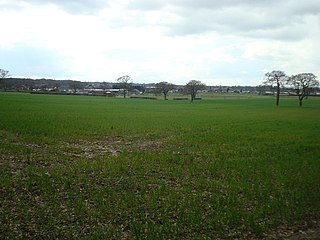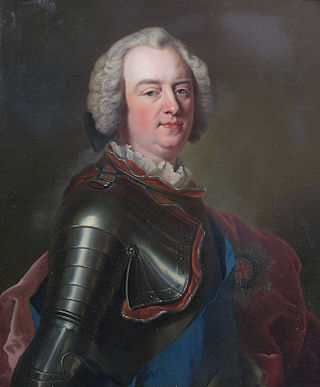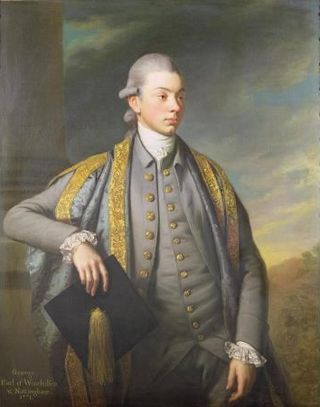
Marylebone Cricket Club (MCC) is a cricket club founded in 1787 and based since 1814 at Lord's Cricket Ground, which it owns, in St John's Wood, London. The club was formerly the governing body of cricket retaining considerable global influence.

John Frederick Sackville, 3rd Duke of Dorset, KG was the only son of Lord John Philip Sackville, second son of Lionel Sackville, 1st Duke of Dorset. His mother was the former Lady Frances Leveson-Gower. He succeeded to the dukedom in 1769 on the death of his uncle, Charles Sackville, 2nd Duke of Dorset. He was the British Ambassador to France from 1784 and returned to England in August 1789 following the escalation of the French Revolution.

Bromley Common is the area of south-east London, within the London Borough of Bromley, Greater London. Prior to 1965 it was within the historic county of Kent. It lies south of Bromley town centre and Bickley, west of Southborough and Petts Wood, north of Locksbottom and Keston, and east of Hayes.

Charles Lennox, 2nd Duke of Richmond, 2nd Duke of Lennox, 2nd Duke of Aubigny, of Goodwood House near Chichester in Sussex, was a British nobleman and politician. He was the son of Charles Lennox, 1st Duke of Richmond, 1st Duke of Lennox, the youngest of the seven illegitimate sons of King Charles II. He was the most important of the early patrons of the game of cricket and did much to help its evolution from village cricket to first-class cricket.
In the years from 1726 to 1750, cricket became an established sport in London and the south-eastern counties of England. In 1726, it was already a thriving sport in the south east and, though limited by the constraints of travel at the time, it was slowly gaining adherents in other parts of England, its growth accelerating with references being found in many counties. Having been essentially a rural pastime for well over a century, cricket became a focus for wealthy patrons and gamblers whose interests funded its growth throughout the 18th century.
Lord John Philip Sackville was the second son of Lionel Sackville, 1st Duke of Dorset. He was a keen cricketer who was closely connected with the sport in Kent.

Turf Moor is an association football stadium in Burnley, Lancashire, England, which has been the home of Burnley Football Club since 1883. This unbroken service makes Turf Moor the second-longest continuously used ground in English professional football. The stadium is situated on Harry Potts Way, named after the manager who won the 1959–60 First Division with the club, and has a capacity of 21,944.

In the 1772 English cricket season, it became normal practice to complete match scorecards and there are surviving examples from every subsequent season. Scorecards from 1772 have been found for three eleven-a-side matches in which the Hampshire county team played against an England team, and for one top-class single wicket match between Kent and Hampshire. The three Hampshire v England matches have been unofficially recognised by certain sources as first-class, although no such standard existed at the time. Prior to 1772, only four scorecards have survived, the last from a minor match in 1769.
Edwin Stead was a noted patron of English cricket, particularly of Kent teams in the 1720s. He usually captained his teams but nothing is known about his ability as a player. He was born at Harrietsham in Kent and died in London.

Vincent Square is a grass-covered square in Westminster, London, England, covering 13 acres, lined with mature trees including London Planes. In among a network of backstreets, it chiefly provides playing fields for Westminster School, who own it absolutely; otherwise, it functions as a green lung and a view for the homes, hotel and other organisations adjoining. Nine of its adjoining buildings have been given strict statutory architectural recognition and protection.
Charles Henry Reynolds Wollaston was an English footballer who played as a forward for Wanderers and England. He won the FA Cup five times with Wanderers, becoming the first player to do so. Wollaston was born in Felpham, Sussex and died in Westminster.
The Sheffield Cricket Club was founded in the 18th century and soon began to play a key role in the development of cricket in northern England. It was the direct forerunner of Yorkshire County Cricket Club and some of the teams fielded by Sheffield were styled Yorkshire. Sheffield generally held first-class status, depending on the quality of their opponents, from 1827 to 1855.

George Finch, 9th Earl of Winchilsea, was an English peer, army officer and cricketer who was an important figure in the history of cricket. His main contributions to the game were patronage and organisation but Winchilsea, an amateur, was also a very keen player. Finch served with the 87th Foot at the time of the American Revolutionary War from its formation in 1779 to its disbanding in 1783, with the temporary ranks of major and lieutenant-colonel. Finch was the first president of the Royal Institution, and it was through his influence that it received the endorsement of King George III.

Burnley Cricket Club is a cricket club in the Lancashire League based at Turf Moor in Burnley, Lancashire.
A variety of Kent county cricket teams played matches from the early 18th century until the formation of the original county club in 1842. The county's links to cricket go back further with Kent and Sussex generally accepted as the birthplace of the sport. It is widely believed that cricket was first played by children living on the Weald in Saxon or Norman times. The world's earliest known organised match was held in Kent c.1611 and the county has always been at the forefront of cricket's development through the growth of village cricket in the 17th century to representative matches in the 18th. A Kent team took part in the earliest known inter-county match, which was played on Dartford Brent in 1709.
In the 1773 English cricket season, there was a downturn in the fortunes of the Hambledon Club as their Hampshire team lost every match they are known to have played, and some of their defeats were heavy. Their poor results owed much to star bowler Thomas Brett having been injured. Three other county teams were active: Kent, Middlesex and Surrey. Teams called England took part in five matches, all against Hampshire, and won all five.
Addington Cricket Club fielded one of the strongest cricket teams in England from about the 1743 season to the 1752 season although the village of Addington is a very small place in Surrey about three miles south-east of Croydon. The team was of county strength and featured the noted players Tom Faulkner, Joe Harris, John Harris, George Jackson and Durling. The team immediately accepted the Slindon Challenge, in 1744, to play against any parish in England. The only other club to accept was Robert Colchin's Bromley.
Cricket, and hence English amateur cricket, probably began in England during the medieval period but the earliest known reference concerns the game being played c.1550 by children on a plot of land at the Royal Grammar School, Guildford, Surrey. It is generally believed that cricket was originally a children's game as it is not until the beginning of the 17th century that reports can be found of adult participation.
The beginning of the 18th century saw sport acquire increasing importance in the lives of people in England and Ireland. Professionalism was by then established in the major gambling sports of bare-knuckle boxing, cricket and horse racing.
Farnham Cricket Club is based at Farnham in Surrey. It was founded in 1782 and for many years was a senior club due to the strength of its team, which featured Billy Beldham and John Wells. Farnham is a member of the Surrey Championship in the twenty-first century, with its first team now playing in the league's third tier Division II. The club's home stadium is at Folly Hill, on the outskirts of Farnham, directly below Farnham Castle.










